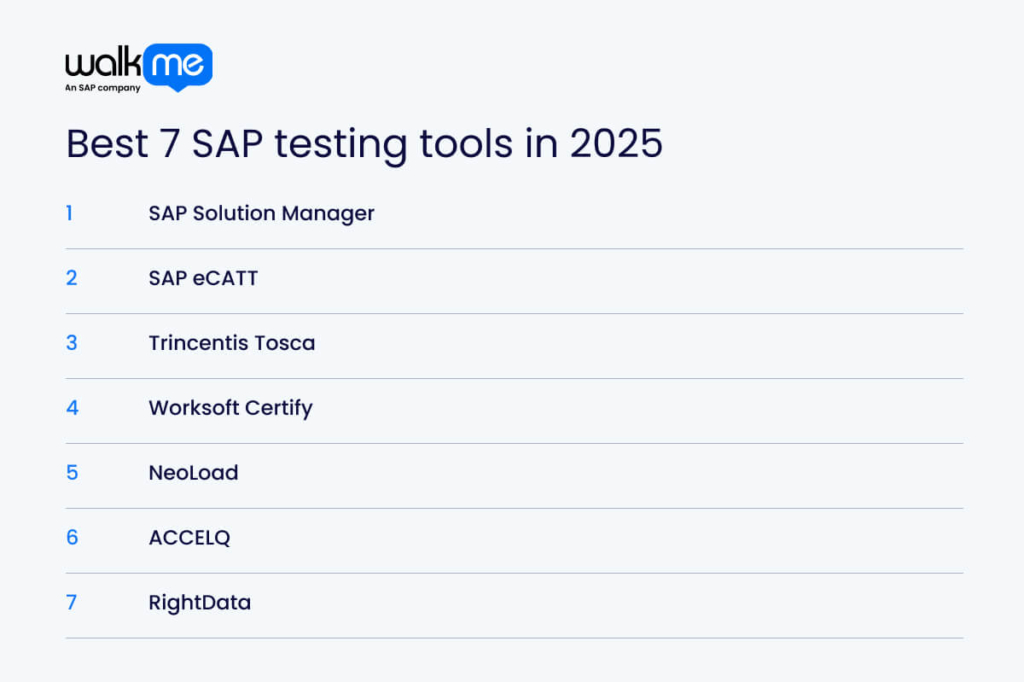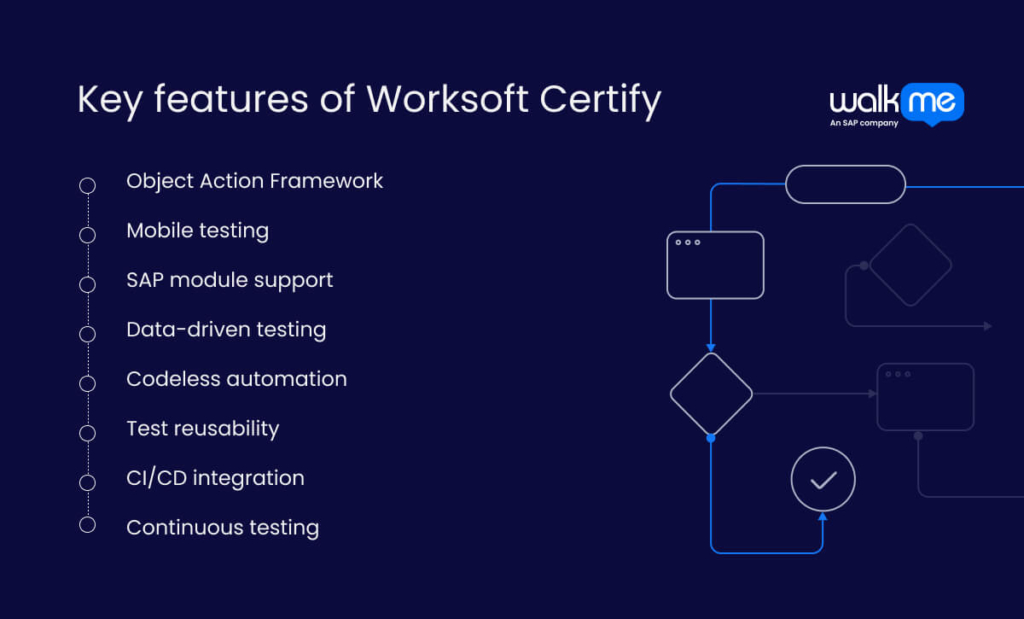Investing in digital transformation remains challenging, as IT teams continue to face tight budgets and limited resources. They must deliver software quickly while maintaining a good customer experience.
Software testing, including that done with SAP testing tools, can help them achieve this goal as it verifies that an app works as intended. A testing plan helps identify bugs or errors that cause the system to fail and spot user experience problems. Catching issues early makes them cheaper to fix, which saves time, money, and reputation.
But, selecting the right SAP testing tool isn’t easy. There are numerous options, ranging from SAP-native tools to third-party solutions. In this article, we’ll explore the seven best SAP testing tools and help you choose the one that fits your needs.

1. SAP Solution Manager
Best For: Companies with large or complex SAP environments that require visibility and control over all operations.
SAP Solution Manager helps IT teams manage, monitor, and improve SAP systems from a single, central location. It works with both SAP and non-SAP tools, including ECC, S/4HANA, SAP Cloud ALM, and third-party apps.
Teams can use it to track system performance, handle testing, and keep business processes running well. It supports every stage of the SAP lifecycle, including setup, operations, updates, and improvements.
Key features:
- Track and resolve IT issues quickly: Incident and problem management tools help teams handle support tickets, change requests, and link with tools like ServiceNow.
- Control and monitor all SAP systems in one place: Centralized management gives teams complete visibility into cloud, on-premise, and hybrid SAP environments.
- Monitor system health in real-time: System monitoring tools display performance, availability, and resource usage, enabling teams to prevent downtime.
- Keep your custom code under control: Custom code management tools help clean up, monitor, and improve custom SAP developments.
- Manage SAP projects from start to finish: Project management tools let teams plan, document, and track SAP rollouts, upgrades, and changes.
- Run tests and ensure quality: Test management features help teams create, execute, and track tests. Solution Manager also works with tools like UiPath to support automation.
- Connect with all your tools: Solution Manager supports integration with other SAP and non-SAP platforms, including cloud apps and third-party services.
2. SAP eCATT
Best For: Users who want to reduce manual testing and check that their SAP processes work as expected.
SAP eCATT (Extended Computer-Aided Test Tool) is a built-in tool that helps automate functional testing in SAP. It works directly with SAP systems, allowing users to test transactions, reports, and business processes. eCATT also integrates with SAP tools such as SAP GUI (Windows and Java) and the Object Navigator (SE80).
Key features:
- Detailed test logs: Each test run generates a detailed log that records the test results and outcome.
- Testing based on scenarios: Test scripts can use different input values to cover a variety of scenarios.
- Centralized management: All eCATT test scripts and data are stored and managed in a single SAP system, making updates easier.
- ABAP integration: Users can include ABAP code in test scripts for more advanced logic and flexibility.
- Recording and playback: Employees can record actions in SAP and replay them as test scripts for automation.
- Tool integration: eCATT can work with other testing tools to expand its capabilities ot to test non-SAP systems.
3. Trincentis Tosca
Best For: Companies that want to simplify testing, automate end-to-end processes, and keep up with fast release cycles.
Tricentis Tosca is a test automation platform that helps teams run tests across both SAP and non-SAP systems. Many companies utilize Tosca during SAP projects to accelerate deployments, migrate to the cloud, and mitigate testing risks.
It connects well with tools like SAP Solution Manager and SAP Cloud ALM to deliver higher-quality releases with fewer errors.
Key features:
- Reporting and analytics: Detailed reports enable teams to identify issues early and make informed decisions with clear insights.
- Risk-based testing: Tosca helps teams focus on the most critical areas, reducing testing time while increasing coverage.
- Codeless test creation: Businesses can build and maintain tests without writing code, making automation accessible to all users.
- AI-powered automation: AI helps create and update test cases automatically, saving time and reducing manual effort.
- SAP Fiori support: Tosca Copilot can automatically generate tests for SAP Fiori apps, speeding up test creation.
- Cross-platform testing: Teams can test across SAP, web, mobile, and desktop apps in a single test flow.
- Model-based testing: Employees can separate application logic from the test model, making test maintenance faster and easier.
4. Worksoft Certify
Best For: IT leaders who need reliable, end-to-end testing across SAP modules and connected platforms
Worksoft Certify is a test automation tool built for testing complex business processes in large enterprise environments. It works well with SAP and other major systems, such as Oracle and Salesforce, making it a strong choice for teams managing multi-application workflows.
This system also helps automate regression and integration testing to ensure better business operations and reduce manual work.

Key features:
- Object Action Framework: Employees can break down apps into pages and steps, helping teams model real business tasks.
- Mobile testing: Teams can enable testing on mobile apps across different devices.
- SAP module support: Businesses can connect directly with SAP HCM, FI, BI, and SuccessFactors without extra tools.
- Data-driven testing: Users can run the same test with different data inputs to cover a broader range of cases.
- Codeless automation: QA teams and other employees can create tests without writing code.
- Test reusability: You can save time by reusing test steps and reducing duplicate work.
- CI/CD integration: IT teams can easily integrate this tool with others, such as Jenkins and GitLab, to run tests within their development pipeline.
- Continuous testing: Users can test often and get feedback quickly.
5. NeoLoad
Best For: Teams that need to test complete applications across platforms and ensure fast, reliable user experiences.
NeoLoad is a powerful performance and load testing tool built for enterprise use. It helps teams test how well web, mobile, and SAP applications perform under pressure. NeoLoad works especially well for SAP environments, including SAP GUI and Remote Function Calls (RFCs).
Key features:
- Support for SAP systems: You can test SAP GUI, SAP S/4HANA Cloud, and SAP SuccessFactors with dedicated protocols and integrations.
- SAP RFC testing: Developers can simulate RFC traffic between SAP and other systems to check performance.
- Visual test creation: Teams use a no-code or low-code platform to build tests with drag-and-drop tools.
- Advanced scripting: Developers can use JavaScript when they need more control and customization.
- CI/CD pipeline integration: NeoLoad works with Jenkins, GitLab, Bamboo, and other tools to support continuous performance testing.
- Mobile performance simulation: QA teams can simulate different devices, networks, and user behavior to test mobile apps.
- Remote Terminal Emulation (RTE): Testers can validate the performance of older, legacy applications that use RTE technology.
- Real-time performance tracking: Employees can monitor key metrics while tests run and catch issues as they happen.
6. ACCELQ
Best For: Employees who run frequent SAP releases, especially quarterly ones.
ACCELQ is a cloud-based test automation tool that helps teams accelerate and enhance SAP releases. It utilizes AI and a codeless setup, allowing users to build tests without writing any code. This digital tool works well with many SAP tools and supports testing for web, mobile, desktop, and APIs.
Key features:
- No-code test creation: Your organization can build and update tests with a simple drag-and-drop interface.
- AI-driven automation: Users can adopt AI to generate test cases and fix broken elements automatically.
- End-to-end SAP integration: ACCELQ can easily integrate with SAP tools using pre-built assets.
- API and UI testing: You can test both front-end and back-end systems together.
- Built-in test data tools: Employees can manage and reuse test data across test cycles.
- Real-time reporting: Your team can benefit from instant insights with clear, shareable reports.
- Continuous testing support: This tool can integrate with CI/CD pipelines to run tests automatically.
7. RightData
Best For: Businesses that need to test complex data flows between SAP and other systems.
RightData is a data testing tool that helps ensure data accuracy and reliability in SAP systems. It works well for checking data during migrations, integrations, and validations.
Key features:
- No-code interface: Users can create and run tests through a visual dashboard without needing to write code.
- Automated testing: Teams can automate checks for data migration, integration, and quality.
- Data validation: This tool verifies that data is accurate, complete, and consistent across systems.
- Data reconciliation: Users can compare data between sources to find mismatches or missing values.
- AI-powered rule building: Generative AI helps users create validation rules at a quicker pace.
- Real-time reporting: The tool provides live updates on test results and data issues.
- Continuous testing: Teams can test data flows regularly to catch issues early.
- SAP integration: RightData connects easily with both cloud and on-premise SAP systems.
- Compliance support: The platform creates clear audit trails and supports regulatory checks.
- Cost savings: Automation and easy setup reduce testing time and lower overall costs.
How to choose the right SAP testing tool for your enterprise
Choosing the right SAP testing tool impacts the performance of your SAP system and supports your business objectives. You need a tool that fits your specific needs and helps you maximize the value of your SAP investment.
Here’s a comparison table that helps you opt for the right testing tool, depending on business needs:
| Need | Recommended tools | Why? |
| Low-cost automation for SAP | SAP eCATT, SAP Solution Manager | Built into SAP—no added cost |
| No-code for business users | Worksoft Certify, ACCELQ | No programming required, easy for non-technical users |
| End-to-end SAP + non-SAP testing | Tricentis Tosca, Worksoft Certify | Works across multiple platforms and complex workflows |
| Performance testing at scale | NeoLoad | Load and performance testing for SAP GUIs and APIs |
| Agile, fast deployments | ACCELQ, Tricentis Tosca | Designed for CI/CD and rapid release cycles |
| Data migration & validation | RightData | Focused on data integrity and ETL testing |
Maintain the reliability of your SAP systems with the right SAP testing tools
SAP testing tools help businesses maintain system stability during updates and changes. The right tool lets teams run automated, repeatable tests that catch problems early and protect key business processes. A structured testing plan reduces downtime, prevents errors, and lowers compliance risks.
To maximize value, teams should align their testing efforts with system updates, custom features, and day-to-day workflows. Start by focusing on high-impact test cases that matter most to your business, allowing you to grow your automation over time. With the right approach, SAP testing tools can enhance system reliability and facilitate faster, safer changes throughout your organization.
FAQs
SAP testing tools help verify that SAP systems and business processes continue to function correctly after updates or changes. They help find and fix problems early. These tools fall into three main types: automation tools, performance testing tools, and data and security management tools.
SAP testing tools are crucial for ensuring that SAP systems operate efficiently, run smoothly, and remain secure. These systems are crucial to the operation of many businesses. The tools help automate testing, saving time and reducing the likelihood of mistakes.
Small businesses can utilize SAP testing tools to ensure their systems function correctly and remain reliable. These tools can automate repeated tasks, check more parts of the system, and help prevent mistakes during updates. By incorporating these tools into their daily work, small businesses can accelerate testing and implement changes more quickly.

